Safety and Reliability Analysis of the Bhopal Gas Tragedy: A Report
VerifiedAdded on 2020/04/15
|14
|2481
|365
Report
AI Summary
This report provides a comprehensive analysis of the Bhopal disaster, examining the safety and reliability failures that led to the tragic event. It begins with an introduction to the context of the disaster, including the industrial setting and the specific hazards involved, such as methyl isocyanate (MIC). The report details the causes of the accident, including the failure of safety systems, inadequate management practices, and human error. It discusses the consequences of the disaster, including the immediate and long-term impacts on the affected population. The report then explores lessons learned from the Bhopal tragedy, emphasizing the importance of hazard assessment, safety management, and emergency preparedness. The second part of the report employs fault tree analysis to examine the specific events that led to the release of chlorine gas, and the minimal cut sets are calculated. The report concludes with a discussion of the importance of commitment to safety, hazard management, and the application of methods like HAZOP to prevent future industrial disasters. References are also included.

Safety and reliability
Paraphrase This Document
Need a fresh take? Get an instant paraphrase of this document with our AI Paraphraser
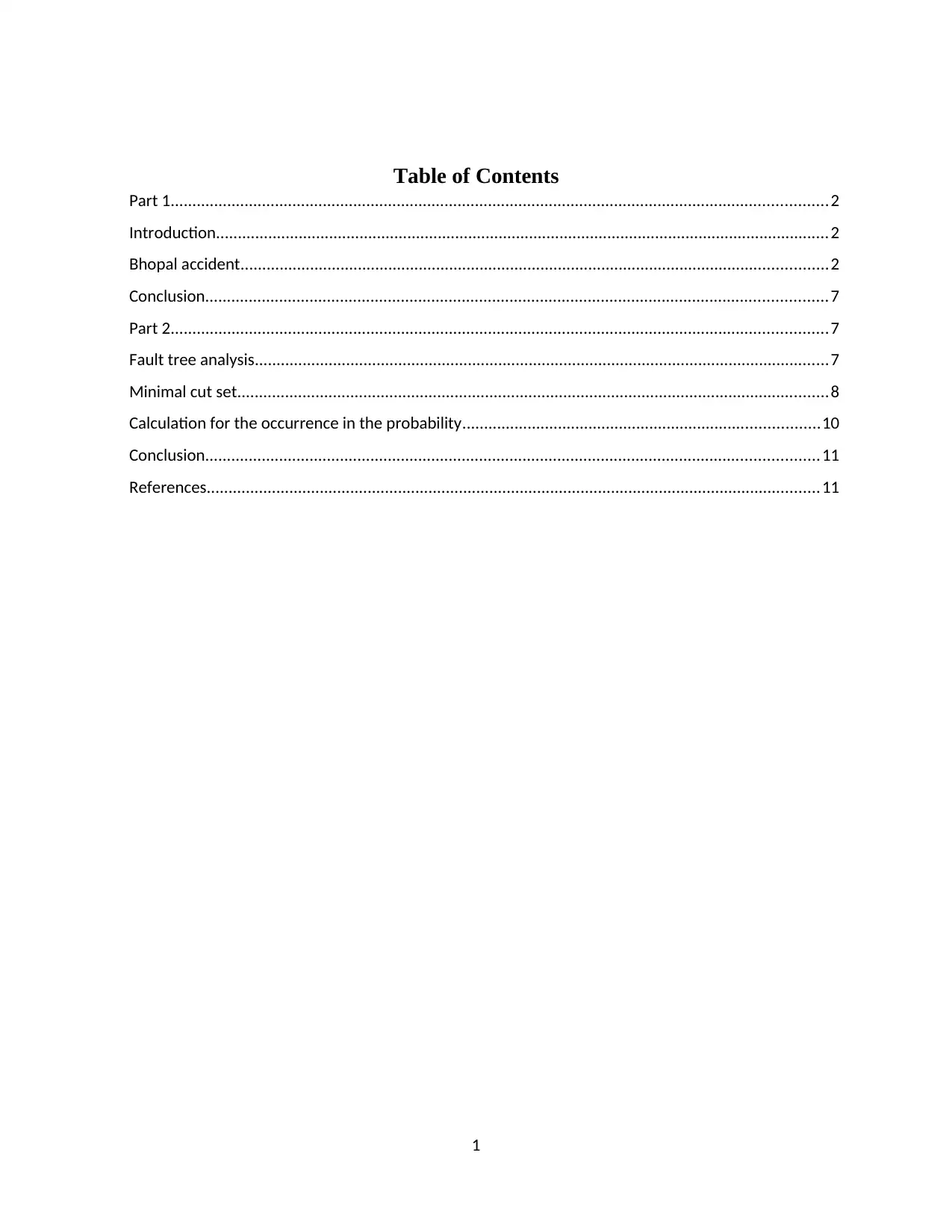
Table of Contents
Part 1.......................................................................................................................................................2
Introduction.............................................................................................................................................2
Bhopal accident.......................................................................................................................................2
Conclusion...............................................................................................................................................7
Part 2.......................................................................................................................................................7
Fault tree analysis....................................................................................................................................7
Minimal cut set........................................................................................................................................8
Calculation for the occurrence in the probability..................................................................................10
Conclusion.............................................................................................................................................11
References.............................................................................................................................................11
1
Part 1.......................................................................................................................................................2
Introduction.............................................................................................................................................2
Bhopal accident.......................................................................................................................................2
Conclusion...............................................................................................................................................7
Part 2.......................................................................................................................................................7
Fault tree analysis....................................................................................................................................7
Minimal cut set........................................................................................................................................8
Calculation for the occurrence in the probability..................................................................................10
Conclusion.............................................................................................................................................11
References.............................................................................................................................................11
1
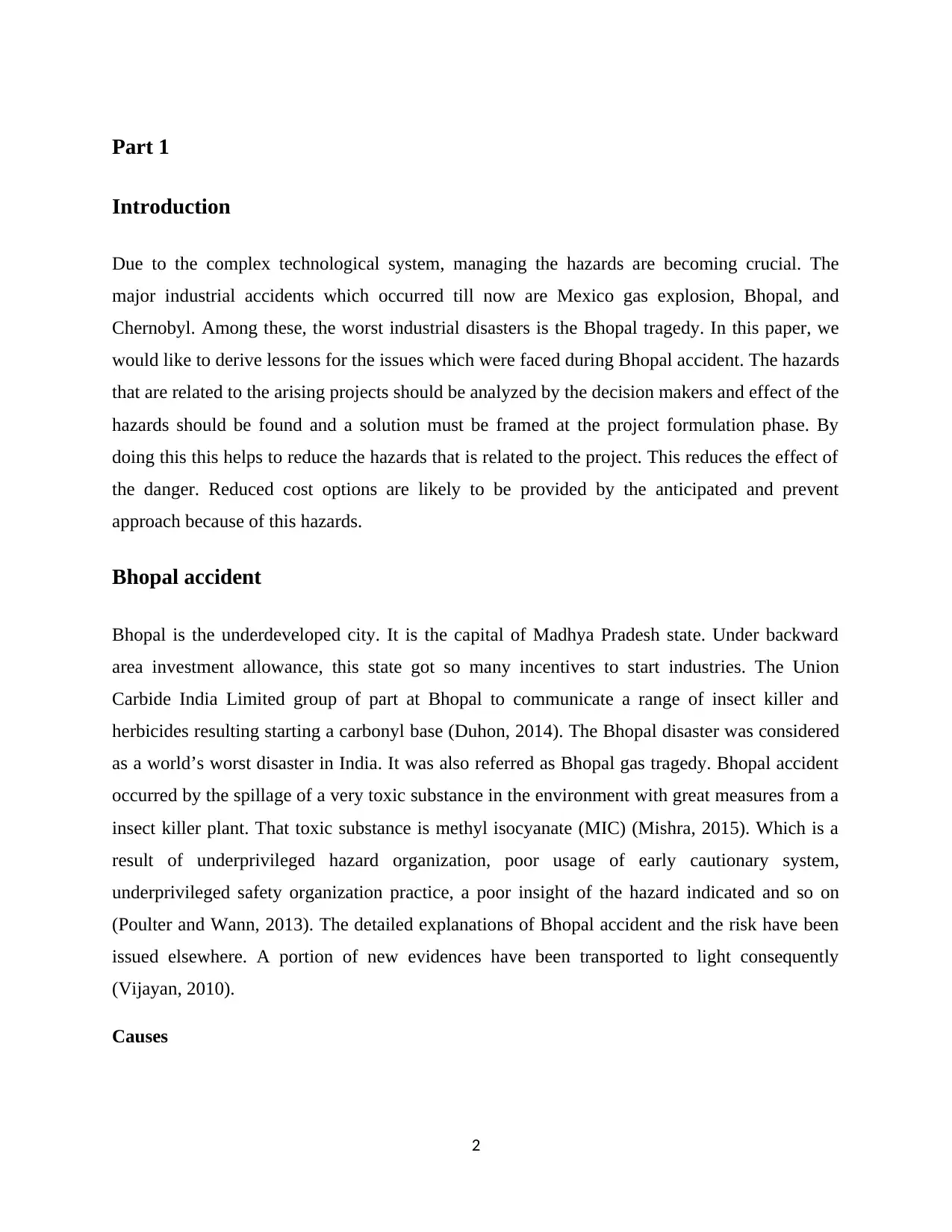
Part 1
Introduction
Due to the complex technological system, managing the hazards are becoming crucial. The
major industrial accidents which occurred till now are Mexico gas explosion, Bhopal, and
Chernobyl. Among these, the worst industrial disasters is the Bhopal tragedy. In this paper, we
would like to derive lessons for the issues which were faced during Bhopal accident. The hazards
that are related to the arising projects should be analyzed by the decision makers and effect of the
hazards should be found and a solution must be framed at the project formulation phase. By
doing this this helps to reduce the hazards that is related to the project. This reduces the effect of
the danger. Reduced cost options are likely to be provided by the anticipated and prevent
approach because of this hazards.
Bhopal accident
Bhopal is the underdeveloped city. It is the capital of Madhya Pradesh state. Under backward
area investment allowance, this state got so many incentives to start industries. The Union
Carbide India Limited group of part at Bhopal to communicate a range of insect killer and
herbicides resulting starting a carbonyl base (Duhon, 2014). The Bhopal disaster was considered
as a world’s worst disaster in India. It was also referred as Bhopal gas tragedy. Bhopal accident
occurred by the spillage of a very toxic substance in the environment with great measures from a
insect killer plant. That toxic substance is methyl isocyanate (MIC) (Mishra, 2015). Which is a
result of underprivileged hazard organization, poor usage of early cautionary system,
underprivileged safety organization practice, a poor insight of the hazard indicated and so on
(Poulter and Wann, 2013). The detailed explanations of Bhopal accident and the risk have been
issued elsewhere. A portion of new evidences have been transported to light consequently
(Vijayan, 2010).
Causes
2
Introduction
Due to the complex technological system, managing the hazards are becoming crucial. The
major industrial accidents which occurred till now are Mexico gas explosion, Bhopal, and
Chernobyl. Among these, the worst industrial disasters is the Bhopal tragedy. In this paper, we
would like to derive lessons for the issues which were faced during Bhopal accident. The hazards
that are related to the arising projects should be analyzed by the decision makers and effect of the
hazards should be found and a solution must be framed at the project formulation phase. By
doing this this helps to reduce the hazards that is related to the project. This reduces the effect of
the danger. Reduced cost options are likely to be provided by the anticipated and prevent
approach because of this hazards.
Bhopal accident
Bhopal is the underdeveloped city. It is the capital of Madhya Pradesh state. Under backward
area investment allowance, this state got so many incentives to start industries. The Union
Carbide India Limited group of part at Bhopal to communicate a range of insect killer and
herbicides resulting starting a carbonyl base (Duhon, 2014). The Bhopal disaster was considered
as a world’s worst disaster in India. It was also referred as Bhopal gas tragedy. Bhopal accident
occurred by the spillage of a very toxic substance in the environment with great measures from a
insect killer plant. That toxic substance is methyl isocyanate (MIC) (Mishra, 2015). Which is a
result of underprivileged hazard organization, poor usage of early cautionary system,
underprivileged safety organization practice, a poor insight of the hazard indicated and so on
(Poulter and Wann, 2013). The detailed explanations of Bhopal accident and the risk have been
issued elsewhere. A portion of new evidences have been transported to light consequently
(Vijayan, 2010).
Causes
2
⊘ This is a preview!⊘
Do you want full access?
Subscribe today to unlock all pages.

Trusted by 1+ million students worldwide
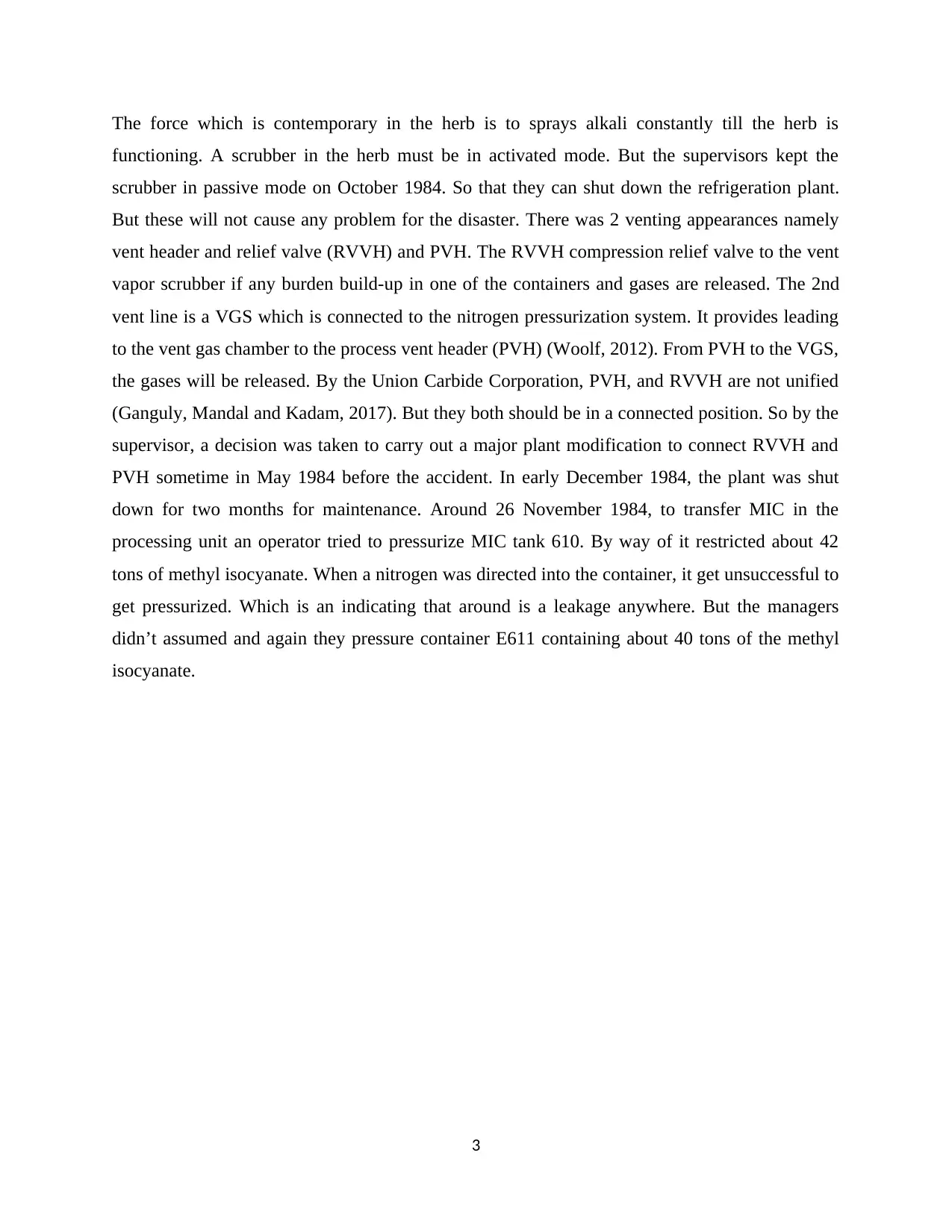
The force which is contemporary in the herb is to sprays alkali constantly till the herb is
functioning. A scrubber in the herb must be in activated mode. But the supervisors kept the
scrubber in passive mode on October 1984. So that they can shut down the refrigeration plant.
But these will not cause any problem for the disaster. There was 2 venting appearances namely
vent header and relief valve (RVVH) and PVH. The RVVH compression relief valve to the vent
vapor scrubber if any burden build-up in one of the containers and gases are released. The 2nd
vent line is a VGS which is connected to the nitrogen pressurization system. It provides leading
to the vent gas chamber to the process vent header (PVH) (Woolf, 2012). From PVH to the VGS,
the gases will be released. By the Union Carbide Corporation, PVH, and RVVH are not unified
(Ganguly, Mandal and Kadam, 2017). But they both should be in a connected position. So by the
supervisor, a decision was taken to carry out a major plant modification to connect RVVH and
PVH sometime in May 1984 before the accident. In early December 1984, the plant was shut
down for two months for maintenance. Around 26 November 1984, to transfer MIC in the
processing unit an operator tried to pressurize MIC tank 610. By way of it restricted about 42
tons of methyl isocyanate. When a nitrogen was directed into the container, it get unsuccessful to
get pressurized. Which is an indicating that around is a leakage anywhere. But the managers
didn’t assumed and again they pressure container E611 containing about 40 tons of the methyl
isocyanate.
3
functioning. A scrubber in the herb must be in activated mode. But the supervisors kept the
scrubber in passive mode on October 1984. So that they can shut down the refrigeration plant.
But these will not cause any problem for the disaster. There was 2 venting appearances namely
vent header and relief valve (RVVH) and PVH. The RVVH compression relief valve to the vent
vapor scrubber if any burden build-up in one of the containers and gases are released. The 2nd
vent line is a VGS which is connected to the nitrogen pressurization system. It provides leading
to the vent gas chamber to the process vent header (PVH) (Woolf, 2012). From PVH to the VGS,
the gases will be released. By the Union Carbide Corporation, PVH, and RVVH are not unified
(Ganguly, Mandal and Kadam, 2017). But they both should be in a connected position. So by the
supervisor, a decision was taken to carry out a major plant modification to connect RVVH and
PVH sometime in May 1984 before the accident. In early December 1984, the plant was shut
down for two months for maintenance. Around 26 November 1984, to transfer MIC in the
processing unit an operator tried to pressurize MIC tank 610. By way of it restricted about 42
tons of methyl isocyanate. When a nitrogen was directed into the container, it get unsuccessful to
get pressurized. Which is an indicating that around is a leakage anywhere. But the managers
didn’t assumed and again they pressure container E611 containing about 40 tons of the methyl
isocyanate.
3
Paraphrase This Document
Need a fresh take? Get an instant paraphrase of this document with our AI Paraphraser
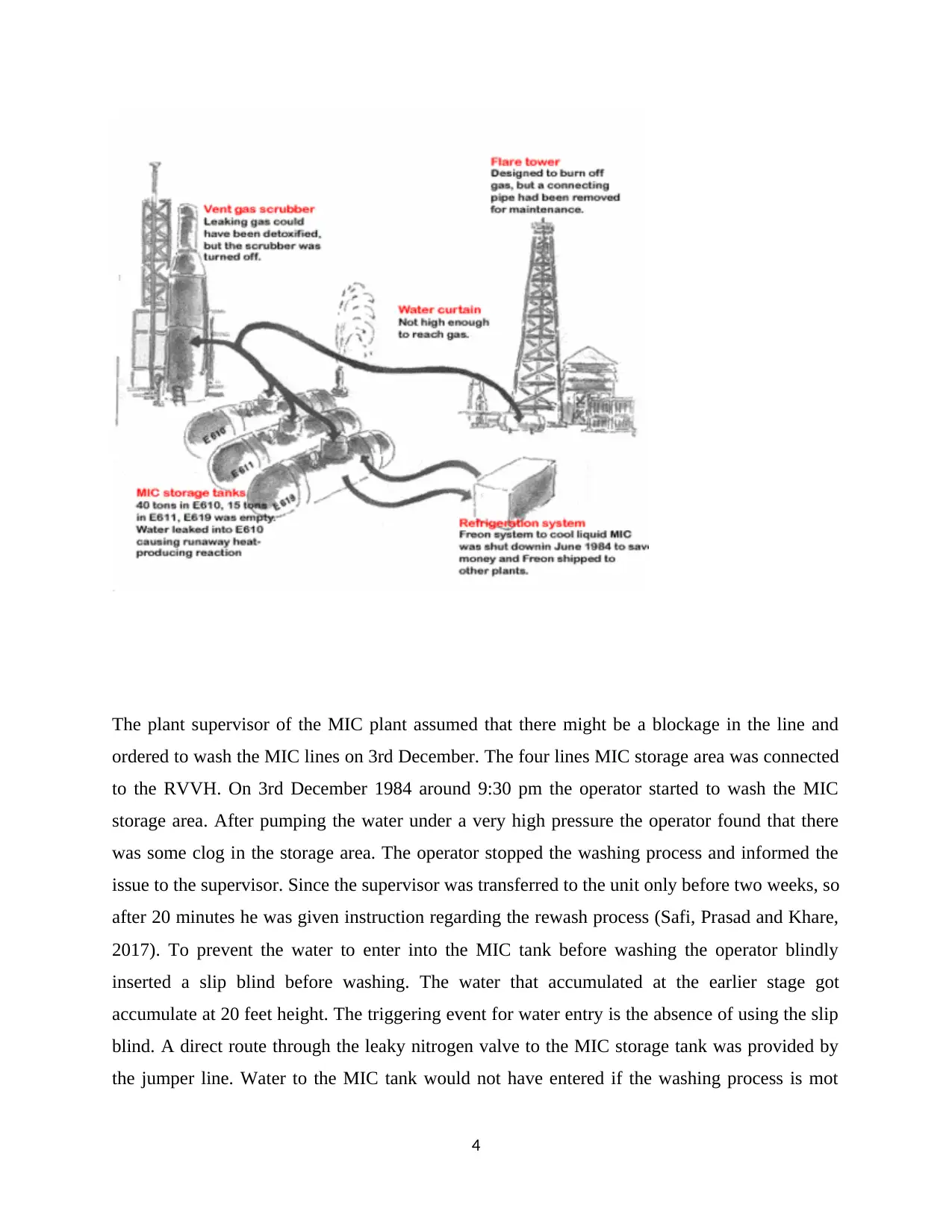
The plant supervisor of the MIC plant assumed that there might be a blockage in the line and
ordered to wash the MIC lines on 3rd December. The four lines MIC storage area was connected
to the RVVH. On 3rd December 1984 around 9:30 pm the operator started to wash the MIC
storage area. After pumping the water under a very high pressure the operator found that there
was some clog in the storage area. The operator stopped the washing process and informed the
issue to the supervisor. Since the supervisor was transferred to the unit only before two weeks, so
after 20 minutes he was given instruction regarding the rewash process (Safi, Prasad and Khare,
2017). To prevent the water to enter into the MIC tank before washing the operator blindly
inserted a slip blind before washing. The water that accumulated at the earlier stage got
accumulate at 20 feet height. The triggering event for water entry is the absence of using the slip
blind. A direct route through the leaky nitrogen valve to the MIC storage tank was provided by
the jumper line. Water to the MIC tank would not have entered if the washing process is mot
4
ordered to wash the MIC lines on 3rd December. The four lines MIC storage area was connected
to the RVVH. On 3rd December 1984 around 9:30 pm the operator started to wash the MIC
storage area. After pumping the water under a very high pressure the operator found that there
was some clog in the storage area. The operator stopped the washing process and informed the
issue to the supervisor. Since the supervisor was transferred to the unit only before two weeks, so
after 20 minutes he was given instruction regarding the rewash process (Safi, Prasad and Khare,
2017). To prevent the water to enter into the MIC tank before washing the operator blindly
inserted a slip blind before washing. The water that accumulated at the earlier stage got
accumulate at 20 feet height. The triggering event for water entry is the absence of using the slip
blind. A direct route through the leaky nitrogen valve to the MIC storage tank was provided by
the jumper line. Water to the MIC tank would not have entered if the washing process is mot
4
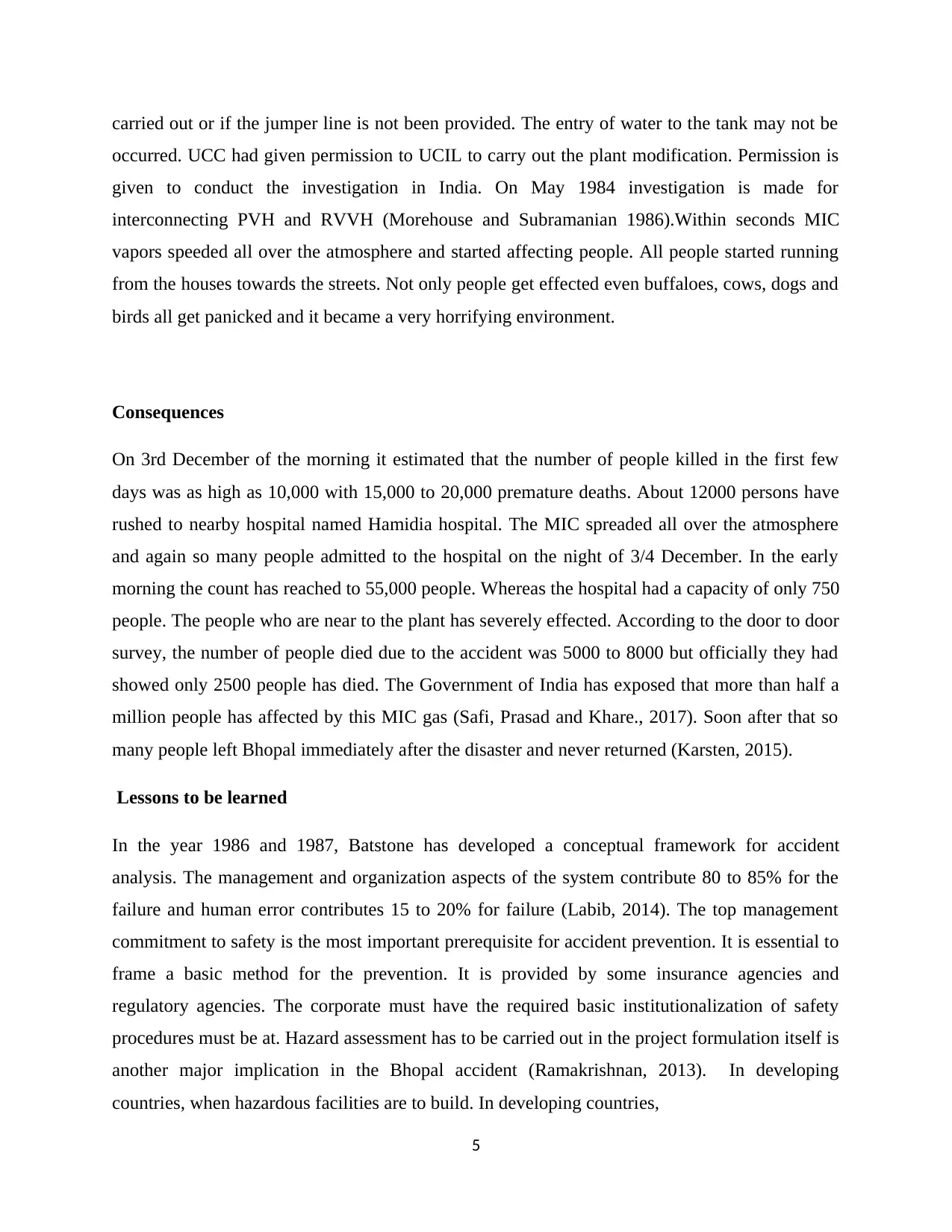
carried out or if the jumper line is not been provided. The entry of water to the tank may not be
occurred. UCC had given permission to UCIL to carry out the plant modification. Permission is
given to conduct the investigation in India. On May 1984 investigation is made for
interconnecting PVH and RVVH (Morehouse and Subramanian 1986).Within seconds MIC
vapors speeded all over the atmosphere and started affecting people. All people started running
from the houses towards the streets. Not only people get effected even buffaloes, cows, dogs and
birds all get panicked and it became a very horrifying environment.
Consequences
On 3rd December of the morning it estimated that the number of people killed in the first few
days was as high as 10,000 with 15,000 to 20,000 premature deaths. About 12000 persons have
rushed to nearby hospital named Hamidia hospital. The MIC spreaded all over the atmosphere
and again so many people admitted to the hospital on the night of 3/4 December. In the early
morning the count has reached to 55,000 people. Whereas the hospital had a capacity of only 750
people. The people who are near to the plant has severely effected. According to the door to door
survey, the number of people died due to the accident was 5000 to 8000 but officially they had
showed only 2500 people has died. The Government of India has exposed that more than half a
million people has affected by this MIC gas (Safi, Prasad and Khare., 2017). Soon after that so
many people left Bhopal immediately after the disaster and never returned (Karsten, 2015).
Lessons to be learned
In the year 1986 and 1987, Batstone has developed a conceptual framework for accident
analysis. The management and organization aspects of the system contribute 80 to 85% for the
failure and human error contributes 15 to 20% for failure (Labib, 2014). The top management
commitment to safety is the most important prerequisite for accident prevention. It is essential to
frame a basic method for the prevention. It is provided by some insurance agencies and
regulatory agencies. The corporate must have the required basic institutionalization of safety
procedures must be at. Hazard assessment has to be carried out in the project formulation itself is
another major implication in the Bhopal accident (Ramakrishnan, 2013). In developing
countries, when hazardous facilities are to build. In developing countries,
5
occurred. UCC had given permission to UCIL to carry out the plant modification. Permission is
given to conduct the investigation in India. On May 1984 investigation is made for
interconnecting PVH and RVVH (Morehouse and Subramanian 1986).Within seconds MIC
vapors speeded all over the atmosphere and started affecting people. All people started running
from the houses towards the streets. Not only people get effected even buffaloes, cows, dogs and
birds all get panicked and it became a very horrifying environment.
Consequences
On 3rd December of the morning it estimated that the number of people killed in the first few
days was as high as 10,000 with 15,000 to 20,000 premature deaths. About 12000 persons have
rushed to nearby hospital named Hamidia hospital. The MIC spreaded all over the atmosphere
and again so many people admitted to the hospital on the night of 3/4 December. In the early
morning the count has reached to 55,000 people. Whereas the hospital had a capacity of only 750
people. The people who are near to the plant has severely effected. According to the door to door
survey, the number of people died due to the accident was 5000 to 8000 but officially they had
showed only 2500 people has died. The Government of India has exposed that more than half a
million people has affected by this MIC gas (Safi, Prasad and Khare., 2017). Soon after that so
many people left Bhopal immediately after the disaster and never returned (Karsten, 2015).
Lessons to be learned
In the year 1986 and 1987, Batstone has developed a conceptual framework for accident
analysis. The management and organization aspects of the system contribute 80 to 85% for the
failure and human error contributes 15 to 20% for failure (Labib, 2014). The top management
commitment to safety is the most important prerequisite for accident prevention. It is essential to
frame a basic method for the prevention. It is provided by some insurance agencies and
regulatory agencies. The corporate must have the required basic institutionalization of safety
procedures must be at. Hazard assessment has to be carried out in the project formulation itself is
another major implication in the Bhopal accident (Ramakrishnan, 2013). In developing
countries, when hazardous facilities are to build. In developing countries,
5
⊘ This is a preview!⊘
Do you want full access?
Subscribe today to unlock all pages.

Trusted by 1+ million students worldwide
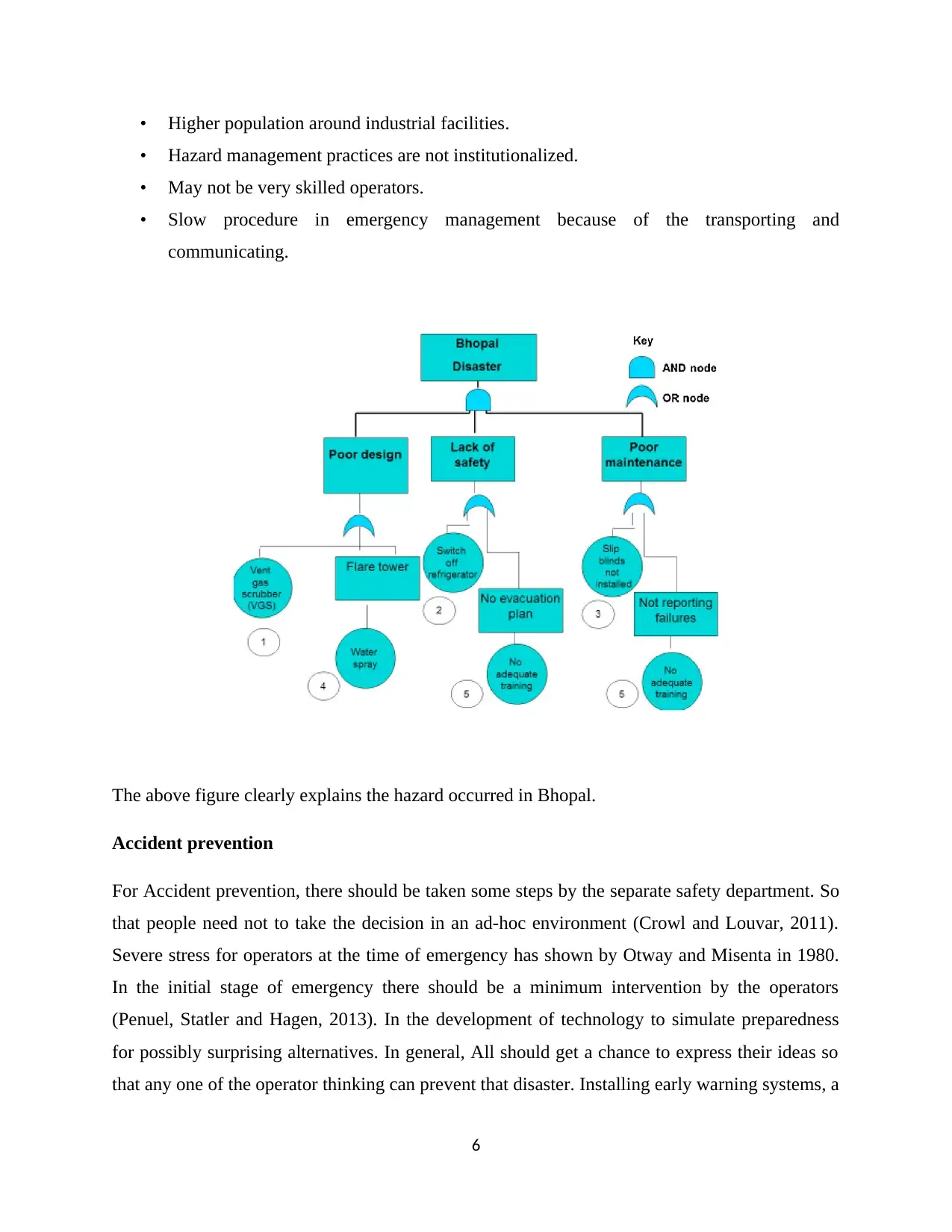
• Higher population around industrial facilities.
• Hazard management practices are not institutionalized.
• May not be very skilled operators.
• Slow procedure in emergency management because of the transporting and
communicating.
The above figure clearly explains the hazard occurred in Bhopal.
Accident prevention
For Accident prevention, there should be taken some steps by the separate safety department. So
that people need not to take the decision in an ad-hoc environment (Crowl and Louvar, 2011).
Severe stress for operators at the time of emergency has shown by Otway and Misenta in 1980.
In the initial stage of emergency there should be a minimum intervention by the operators
(Penuel, Statler and Hagen, 2013). In the development of technology to simulate preparedness
for possibly surprising alternatives. In general, All should get a chance to express their ideas so
that any one of the operator thinking can prevent that disaster. Installing early warning systems, a
6
• Hazard management practices are not institutionalized.
• May not be very skilled operators.
• Slow procedure in emergency management because of the transporting and
communicating.
The above figure clearly explains the hazard occurred in Bhopal.
Accident prevention
For Accident prevention, there should be taken some steps by the separate safety department. So
that people need not to take the decision in an ad-hoc environment (Crowl and Louvar, 2011).
Severe stress for operators at the time of emergency has shown by Otway and Misenta in 1980.
In the initial stage of emergency there should be a minimum intervention by the operators
(Penuel, Statler and Hagen, 2013). In the development of technology to simulate preparedness
for possibly surprising alternatives. In general, All should get a chance to express their ideas so
that any one of the operator thinking can prevent that disaster. Installing early warning systems, a
6
Paraphrase This Document
Need a fresh take? Get an instant paraphrase of this document with our AI Paraphraser
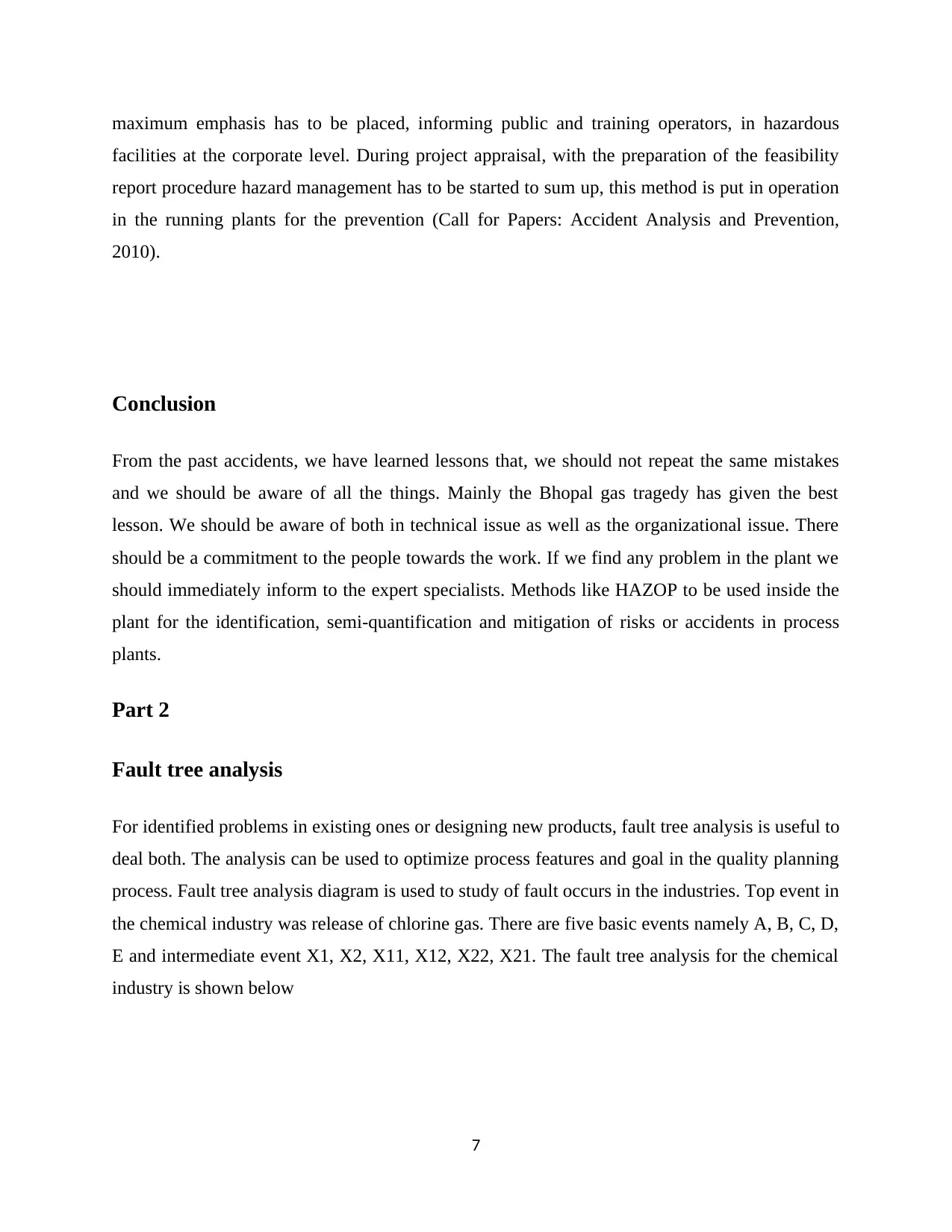
maximum emphasis has to be placed, informing public and training operators, in hazardous
facilities at the corporate level. During project appraisal, with the preparation of the feasibility
report procedure hazard management has to be started to sum up, this method is put in operation
in the running plants for the prevention (Call for Papers: Accident Analysis and Prevention,
2010).
Conclusion
From the past accidents, we have learned lessons that, we should not repeat the same mistakes
and we should be aware of all the things. Mainly the Bhopal gas tragedy has given the best
lesson. We should be aware of both in technical issue as well as the organizational issue. There
should be a commitment to the people towards the work. If we find any problem in the plant we
should immediately inform to the expert specialists. Methods like HAZOP to be used inside the
plant for the identification, semi-quantification and mitigation of risks or accidents in process
plants.
Part 2
Fault tree analysis
For identified problems in existing ones or designing new products, fault tree analysis is useful to
deal both. The analysis can be used to optimize process features and goal in the quality planning
process. Fault tree analysis diagram is used to study of fault occurs in the industries. Top event in
the chemical industry was release of chlorine gas. There are five basic events namely A, B, C, D,
E and intermediate event X1, X2, X11, X12, X22, X21. The fault tree analysis for the chemical
industry is shown below
7
facilities at the corporate level. During project appraisal, with the preparation of the feasibility
report procedure hazard management has to be started to sum up, this method is put in operation
in the running plants for the prevention (Call for Papers: Accident Analysis and Prevention,
2010).
Conclusion
From the past accidents, we have learned lessons that, we should not repeat the same mistakes
and we should be aware of all the things. Mainly the Bhopal gas tragedy has given the best
lesson. We should be aware of both in technical issue as well as the organizational issue. There
should be a commitment to the people towards the work. If we find any problem in the plant we
should immediately inform to the expert specialists. Methods like HAZOP to be used inside the
plant for the identification, semi-quantification and mitigation of risks or accidents in process
plants.
Part 2
Fault tree analysis
For identified problems in existing ones or designing new products, fault tree analysis is useful to
deal both. The analysis can be used to optimize process features and goal in the quality planning
process. Fault tree analysis diagram is used to study of fault occurs in the industries. Top event in
the chemical industry was release of chlorine gas. There are five basic events namely A, B, C, D,
E and intermediate event X1, X2, X11, X12, X22, X21. The fault tree analysis for the chemical
industry is shown below
7
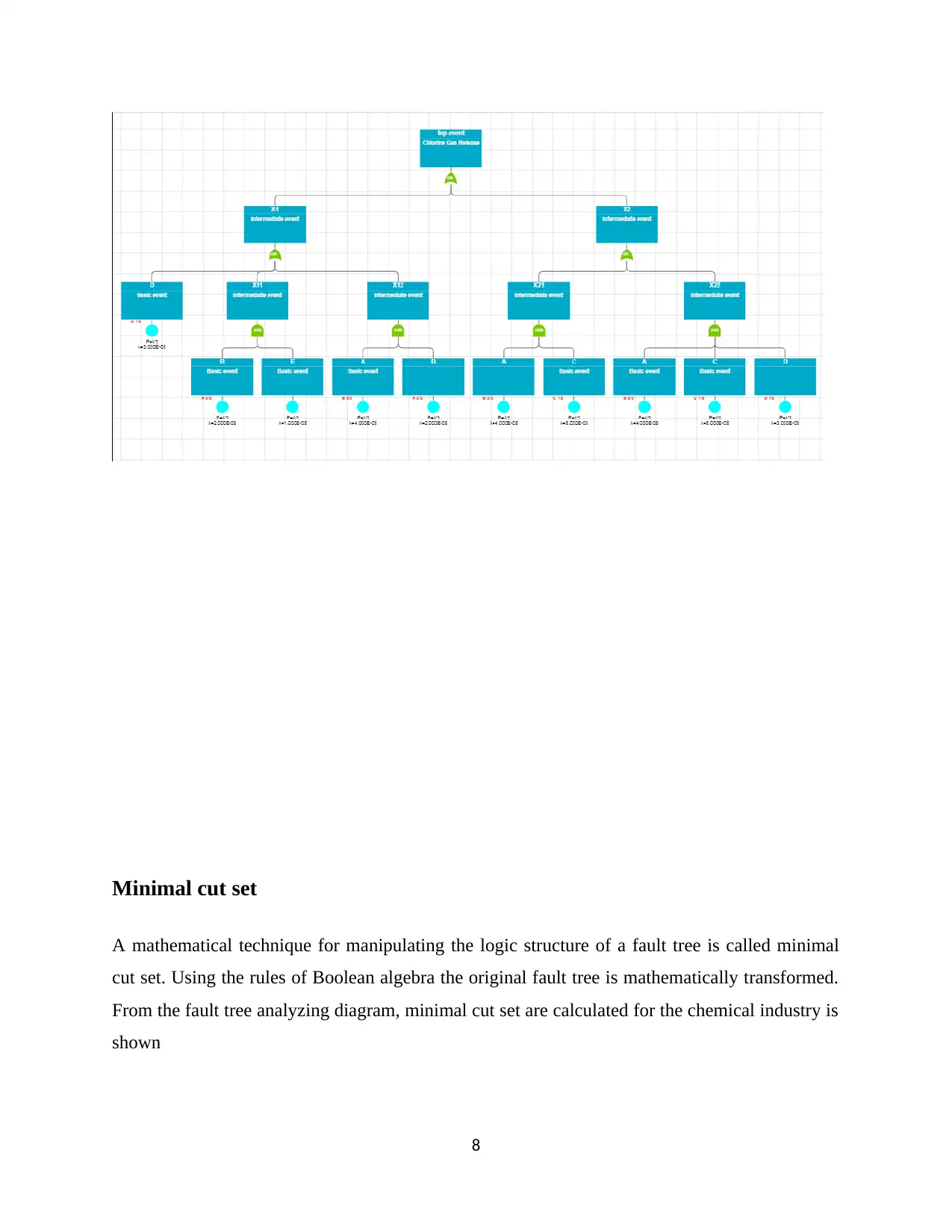
Minimal cut set
A mathematical technique for manipulating the logic structure of a fault tree is called minimal
cut set. Using the rules of Boolean algebra the original fault tree is mathematically transformed.
From the fault tree analyzing diagram, minimal cut set are calculated for the chemical industry is
shown
8
A mathematical technique for manipulating the logic structure of a fault tree is called minimal
cut set. Using the rules of Boolean algebra the original fault tree is mathematically transformed.
From the fault tree analyzing diagram, minimal cut set are calculated for the chemical industry is
shown
8
⊘ This is a preview!⊘
Do you want full access?
Subscribe today to unlock all pages.

Trusted by 1+ million students worldwide
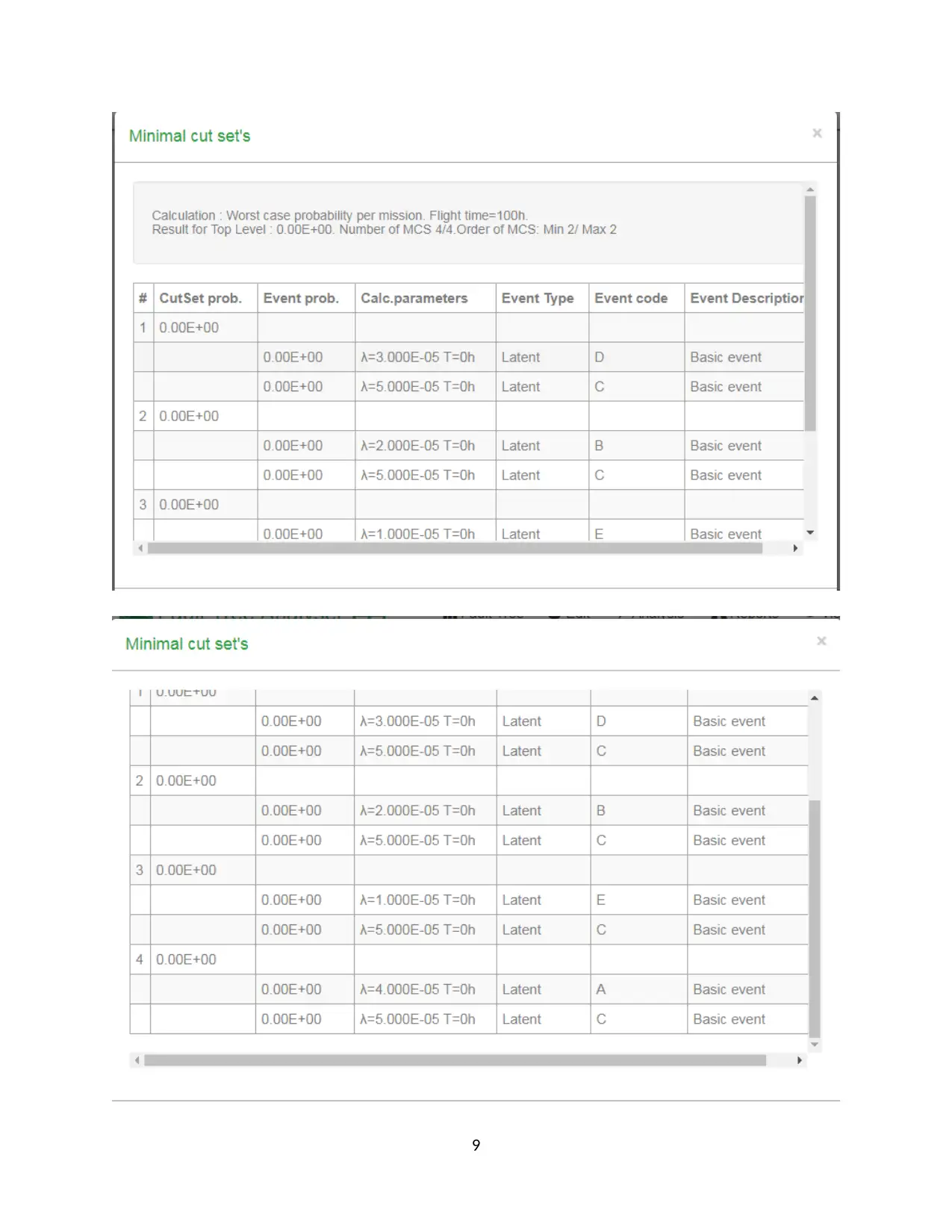
9
Paraphrase This Document
Need a fresh take? Get an instant paraphrase of this document with our AI Paraphraser
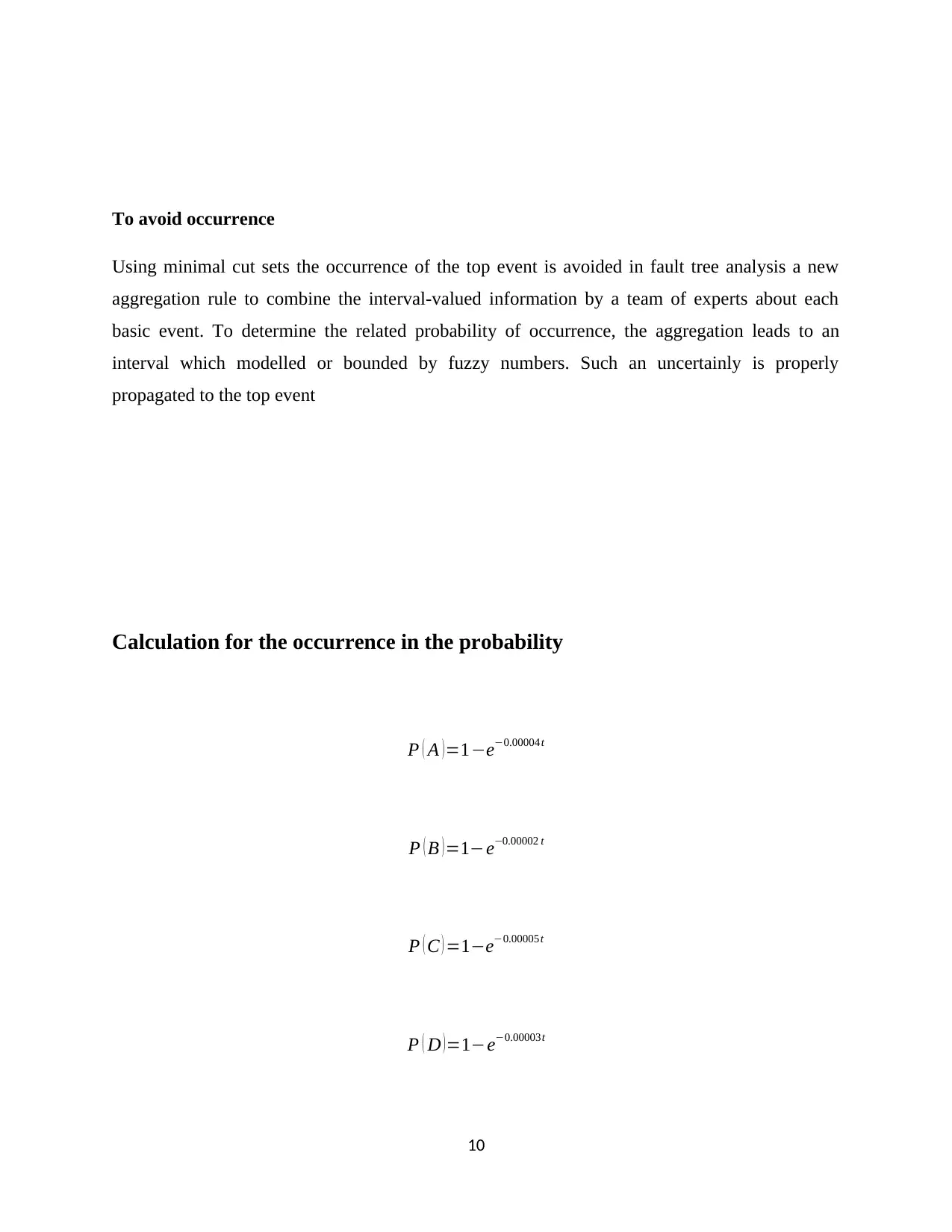
To avoid occurrence
Using minimal cut sets the occurrence of the top event is avoided in fault tree analysis a new
aggregation rule to combine the interval-valued information by a team of experts about each
basic event. To determine the related probability of occurrence, the aggregation leads to an
interval which modelled or bounded by fuzzy numbers. Such an uncertainly is properly
propagated to the top event
Calculation for the occurrence in the probability
P ( A ) =1−e−0.00004t
P ( B )=1−e−0.00002 t
P ( C ) =1−e−0.00005t
P ( D ) =1−e−0.00003t
10
Using minimal cut sets the occurrence of the top event is avoided in fault tree analysis a new
aggregation rule to combine the interval-valued information by a team of experts about each
basic event. To determine the related probability of occurrence, the aggregation leads to an
interval which modelled or bounded by fuzzy numbers. Such an uncertainly is properly
propagated to the top event
Calculation for the occurrence in the probability
P ( A ) =1−e−0.00004t
P ( B )=1−e−0.00002 t
P ( C ) =1−e−0.00005t
P ( D ) =1−e−0.00003t
10
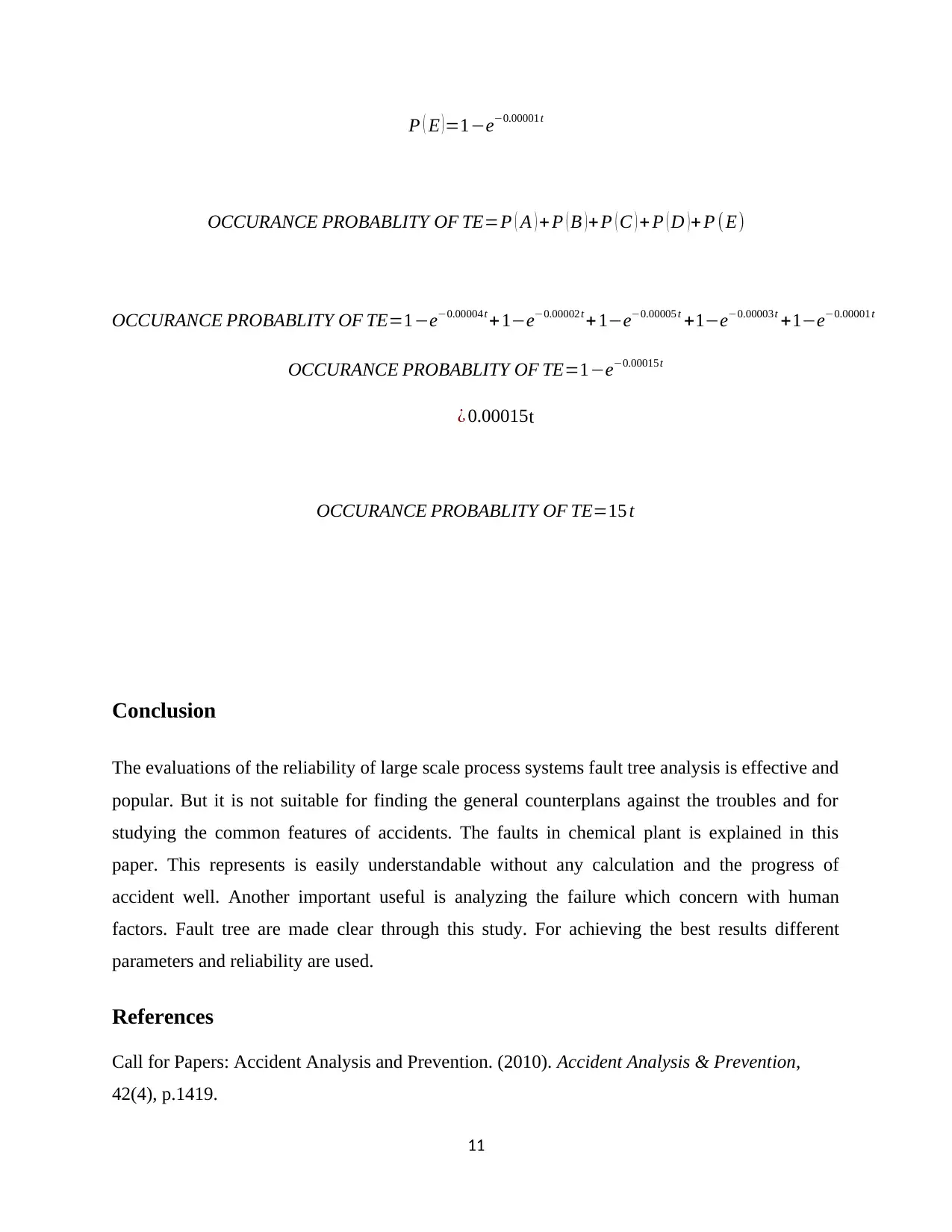
P ( E )=1−e−0.00001t
OCCURANCE PROBABLITY OF TE=P ( A ) + P ( B ) + P ( C ) + P ( D ) + P (E)
OCCURANCE PROBABLITY OF TE=1−e−0.00004 t +1−e−0.00002 t + 1−e−0.00005 t +1−e−0.00003t +1−e−0.00001t
OCCURANCE PROBABLITY OF TE=1−e−0.00015t
¿ 0.00015t
OCCURANCE PROBABLITY OF TE=15 t
Conclusion
The evaluations of the reliability of large scale process systems fault tree analysis is effective and
popular. But it is not suitable for finding the general counterplans against the troubles and for
studying the common features of accidents. The faults in chemical plant is explained in this
paper. This represents is easily understandable without any calculation and the progress of
accident well. Another important useful is analyzing the failure which concern with human
factors. Fault tree are made clear through this study. For achieving the best results different
parameters and reliability are used.
References
Call for Papers: Accident Analysis and Prevention. (2010). Accident Analysis & Prevention,
42(4), p.1419.
11
OCCURANCE PROBABLITY OF TE=P ( A ) + P ( B ) + P ( C ) + P ( D ) + P (E)
OCCURANCE PROBABLITY OF TE=1−e−0.00004 t +1−e−0.00002 t + 1−e−0.00005 t +1−e−0.00003t +1−e−0.00001t
OCCURANCE PROBABLITY OF TE=1−e−0.00015t
¿ 0.00015t
OCCURANCE PROBABLITY OF TE=15 t
Conclusion
The evaluations of the reliability of large scale process systems fault tree analysis is effective and
popular. But it is not suitable for finding the general counterplans against the troubles and for
studying the common features of accidents. The faults in chemical plant is explained in this
paper. This represents is easily understandable without any calculation and the progress of
accident well. Another important useful is analyzing the failure which concern with human
factors. Fault tree are made clear through this study. For achieving the best results different
parameters and reliability are used.
References
Call for Papers: Accident Analysis and Prevention. (2010). Accident Analysis & Prevention,
42(4), p.1419.
11
⊘ This is a preview!⊘
Do you want full access?
Subscribe today to unlock all pages.

Trusted by 1+ million students worldwide
1 out of 14
Your All-in-One AI-Powered Toolkit for Academic Success.
+13062052269
info@desklib.com
Available 24*7 on WhatsApp / Email
![[object Object]](/_next/static/media/star-bottom.7253800d.svg)
Unlock your academic potential
Copyright © 2020–2025 A2Z Services. All Rights Reserved. Developed and managed by ZUCOL.

